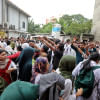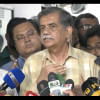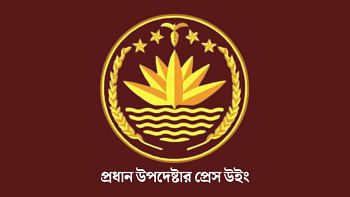Hospital corridors echo with grief and groans

In the aftermath of a devastating air force jet crash into a school, Dhaka's hospitals became the frontline of a tragedy that shook the city to its core. The corridors of the National Institute of Burn and Plastic Surgery became a scene of anguish as scores of critically injured, mostly children, arrived in waves.
For many of them, it was a grim, 20-kilometre journey from the disaster site in Uttara to the country's top burn hospital in Chankharpool. About 70 people were rushed to the facility, many bearing life-threatening injuries. By yesterday afternoon, it became the epicentre of the crisis, as the most critical cases were transferred from smaller, overwhelmed hospitals in the northern part of the city.
Including these 70, at least 88 burn victims were being treated at seven city hospitals last night, with 25 in critical condition, according to health ministry data.
The crash occurred in the heart of densely populated Uttara, where the aircraft plummeted into a two-storey building of Milestone School and College, just after midday. Parents and guardians, many of whom had just arrived for school pickups, rushed into the unfolding chaos. With no time to wait for emergency responders, they carried the wounded out themselves, doing whatever they could to save lives before ambulances arrived.
Outside the burn institute, the scene was one of barely controlled turmoil. Volunteers struggled to clear paths for ambulances and private vehicles. Many of the victims arrived already swathed in bandages, evidence of hastily administered first aid from smaller clinics. Personnel from Ansar and the Rapid Action Battalion were deployed to manage the crowds and keep emergency entrances accessible.
Inside, medical professionals scrambled through triage, fielding frantic inquiries from terrified families while trying to log patients' names and statuses. Medical staff worked under crushing pressure, managing oxygen cylinders, administering pain relief, and coordinating surgeries. Cries of pain echoed through the halls.
Among the wounded was nine-year-old Nusrat, her arm wrapped in thick white gauze. Her uncle had been en route to pick her up from school when he saw the crash unfold. He pulled her from the wreckage with his bare hands. Her mother said she had suffered 25 percent burns.
A panicked man soon approached them, searching for his friend's missing daughter, Nahia Ashraf. He explained that Nahia's brother had already been admitted to the ICU with 95 percent burns. On the fourth floor of the institute, a paper taped to the wall bore a stark testimony: next to patient names were numbers -- 40 percent, 80 percent, and for some, 100 percent.
Outside that room, more than a hundred relatives gathered. Some sat silent on the floor, others wept in one another's arms. Grief and dread hung thick in the air.
In another corridor, a female student in her Milestone School uniform recounted that she and her twin brother were both at school that day. She had left early, around 12:40pm -- just half an hour before the school's scheduled closure. Her brother wasn't as lucky; he was now among the patients being treated inside.
In one corner of the hospital, Akhlima Parvin stood crying in the hallway. Her son, Tawfiq Hossain, a class five student, had just been admitted.
"He had breakfast with me in the morning. I cooked his favourite meal. He was supposed to come back and eat lunch," she said.
Parvin added, "When I heard the blast, I rushed towards the school. I found him injured. He wrapped his arms around me and begged me to save him."
Elsewhere, a woman clung to a relative, sobbing as she described seeing the plane strike the school. Her daughter, also present during the crash, was later found and admitted to the hospital. Her condition was described as stable.
On the sixth floor, crowds gathered outside treatment rooms. Hospital staff struggled to keep them out, citing infection risks. "Your entry may cause infection," one of them warned, trying to control the influx of visitors and concerned relatives.
The scene outside was no less chaotic. Political leaders, advisers, and delegations from various professional bodies arrived at the hospital, often with entourages, unintentionally disrupting emergency operations.
As the sun dipped low, the streets surrounding the institute swelled with people holding makeshift signs, pleading for blood donations, especially negative types. One sign simply read: "O Negative Needed Urgently."
Finance Adviser Salehuddin Ahmed addressed reporters at the institute. "Our immediate priority is to ensure the best possible treatment for the victims. We will look later if any other support is needed."
The National Institute of Burn and Plastic Surgery, inaugurated in October 2018, is the world's largest facility of its kind. With 500 beds, 50 intensive care units, and 12 state-of-the-art operating theatres across 12 floors, it was built to handle one of the most catastrophic medical emergencies.
Today, it is being tested once more.

 For all latest news, follow The Daily Star's Google News channel.
For all latest news, follow The Daily Star's Google News channel. 








Comments